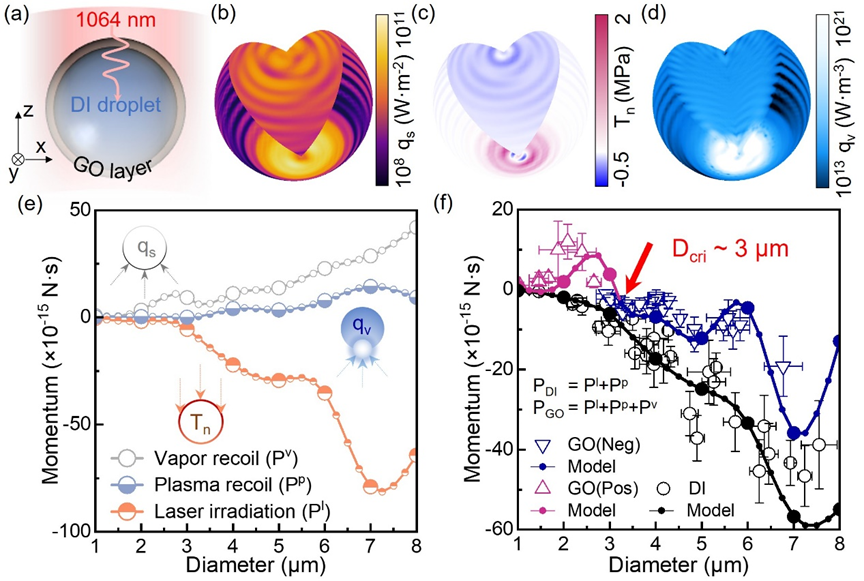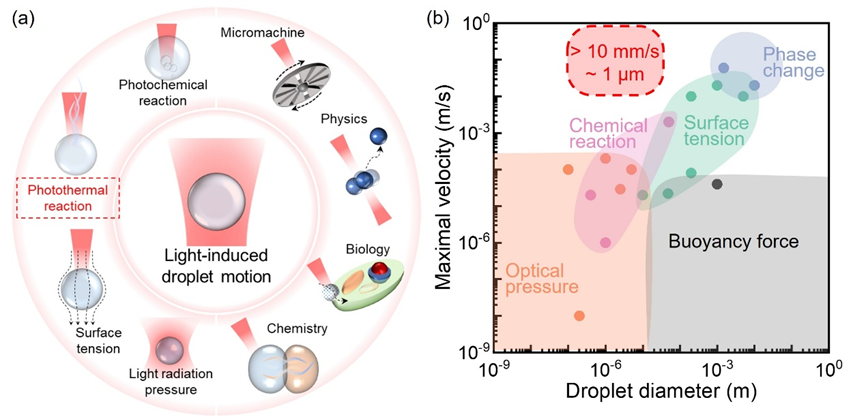Recently, a research team from the School of Materials Science and Engineering of Shanghai Jiao Tong University have made an important progress in the field of microscale photothermal conversion. The relevant work entitled “Phototaxis flight of microdroplets in a laser” was published in Physical Review Letters. This work constructs efficient photothermal conversion layer at the gas-liquid interface of microdroplet and utilizes the photothermal conversion to drive the microdroplet to fly toward the laser (positive phototaxis) or away from it (negative phototaxis). The turnover of microdroplet flight from positive phototaxis to negative one was observed as well. Through experiments and modeling, the research group revealed the key mechanism and factors of phototaxis phenomenon of microdroplet, and realized the regulation of the critical turnover diameter of microdroplet flights. This work demonstrates a photothermal conversion-based method to control the movement of microdroplets, showing application potentials in manipulating of objects at microscale. Ph. D candidate Weizheng Cheng is the first author, and Prof. Tao Deng and Assoc. Prof. Benwei Fu are the corresponding authors.
Droplet interaction with light widely exists in various environments and systems. For instance, water droplets in clouds absorb and reflect sunlight, and laser-tin droplet interaction is utilized as light source for lithography process. Among them, optical manipulation driven by light-droplet interactions (such as by light pressure, surface tension, chemical reaction force, etc.) can control the motion of droplets and has the features of non-contact, high precision, and high throughput. Optical manipulation has been the key technology in areas that include biological cell transfer and colloidal particle capture. In this work, the research team developed a new optical manipulation method based on the controlled photothermal conversion process. They generated the graphene oxide (GO)-containing microdroplet through nebulizing the GO nanofluids. Due to the low surface tension, the GO sheets self-assemble at the air-water interface of the microdroplet and act as an efficient photothermal conversion layer (Fig. 1(a)). Under laser illumination, laser-microdroplet interaction results in the microdroplet-assisted focus of laser, laser-induced optical breakdown, and photothermal conversion at the GO layer, all of which help generate different forces and propel the controlled motion of microdroplets (Fig. 1(b)). Among these processes, the GO layer captures much laser energy at the interface through photothermal conversion and induces rapid interfacial evaporation with strong vapor recoil force, which is the key driving force for the phototaxis flights of the microdroplets.

Fig 1. (a) Illustration of laser-microdroplet interaction. (b) Illustration of driving forces from light radiation, optical breakdown, and photothermal conversion.
The research team established a visualization platform to observe the laser-microdroplet interaction and record the flying behaviors of the microdroplets. The experimental results show that the GO microdroplets with the diameter larger than 3 μm or the DI ones without GO as the photothermal layer all fly away from the laser source (negative phototaxis, top row in Fig. 2(b) and areas marked with blue in Fig. 2(c)). Only the GO microdroplets with the diameter smaller than 3 μm exhibit positive phototaxis and fly toward the laser source (bottom row in Fig. 2(b) and areas marked with red in Fig. 2(c)). The critical diameter for different phototaxis behaviors of GO microdroplet is 3 μm.

Fig 2. Phototaxis phenomenon of microdroplets in a laser. (a) Illustration of visualization platform. (b) Laser-microdroplet interaction pushes a large GO microdroplet away from the laser source, and pulls a small one toward the laser source. (c) Statistic results of phototaxis behaviors of GO and DI microplots.
The research team constructed a multi-physics coupling model (Fig. 3(a)) to study the microscale processes of laser-microdroplet interaction. The modeling results show that during the interaction, the GO photothermal conversion layer captures laser energy into heat at the air-water interface of the microdroplet (Fig. 3(b)), resulting in interfacial evaporation and strong vapor recoil force. The microdroplet affects the laser propagation through reflection and refraction, and thus is subject to the light pressure (Fig. 3(c)). The water inside the microdroplet absorbs the laser energy, triggering optical breakdown with plasma, and is thus subject to the plasma expansion pressure (Fig. 3(d)).
The research team analyzed the effect of diameter in the laser-microdroplet interaction, and the contributions of different processes to the driving forces. The results show that the vapor recoil force is dominative for small GO microdroplets, and the light pressure is dominative for large ones (Fig. 3(e)). The plasma expansion pressure is relatively small compared to the vapor recoil force and light pressure (Fig. 3(e)). The sum of the momentums in Fig. 3(f) shows that the total momentum on DI microdroplets is negative for all diameter, indicating the negative phototaxis flight of DI microdroplet. The total momentum of GO microdroplets changes it sign at 3 μm, indicating the turnover of flight of GO microdroplets at 3 μm. The comparison between GO and DI microdroplets reveals that the GO photothermal conversion layer plays an important role in capturing laser energy at the interface and in generating vapor recoil force for positive phototaxis. Through modeling, the research team studied the microscale processes of laser-microdroplet interaction and revealed the key mechanism of photothermal conversion-driven positive phototaxis flight of microdroplets. The modeling results have good agreement with the experiment observation and analysis, and the established model can be further developed for predicting the phototaxis behaviors and the critical turnover diameter.

Fig. 3. (a) Illustration of modeling of laser interaction with a 3-μm GO microdroplet. (b-d) Distributions of interfacial energy deposition (qs), surface light pressure (Tn), and internal energy deposition (qv). (e) Momentums from light pressure (Pl), vapor recoil (Pv), and plasma expansion (Pp). (f) Total momentumson DI and GO microdroplets.
Based on the mechanism above, the research team enhanced the vapor recoil force through regulating the materials of microdroplet. For GO-ethanol nanofluids, ethanol induces more violent interfacial evaporation with stronger vapor recoil force than water does, raising the critical turnover diameter to 3.8 μm. For Au nanoparticle-water nanofluids, Au nanoparticles absorb more laser than the GO sheets do. The photothermal conversion process is enhanced and the critical turnover diameter is increased to 3.3 μm in comparison to GO-water microdroplets. The turnover flights of the microdroplets from different nanofluids generalize the phototaxis mechanism to a broad range of material systems.
This work proposed a photothermal conversion-based mechanism for the control of microdroplet motion control (Fig. 4(a)), and developed a new approach for optical manipulation of microdroplet with high speed (> 10 mm/s) and direction control (negative and positive phototaxis) (Fig. 4(b)). The developed method can be extended to a broad range of material systems, showing application potentials in the areas that include biological cell capture and colloidal particle manipulation.

Fig. 4. Photothermal conversion-based manipulation method for micro-objects.
